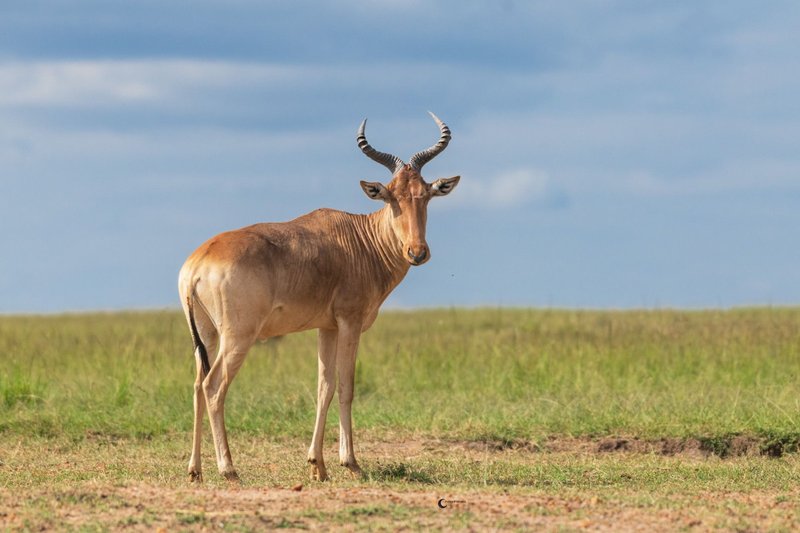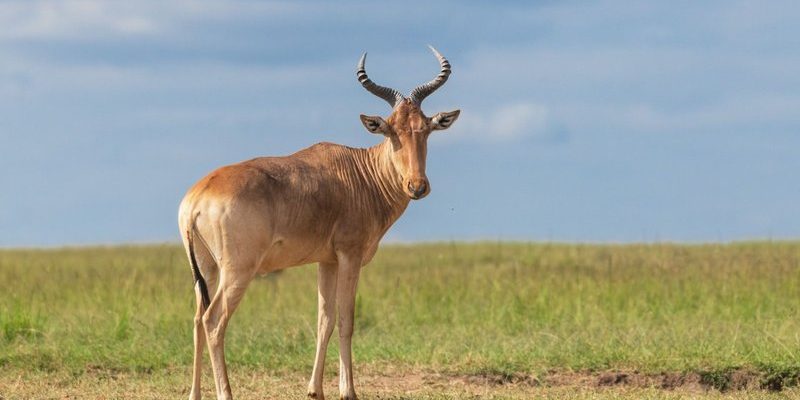
Let’s embark on a journey through the savannas and grasslands to meet ten animals that share traits with the hartebeest. Think of this as a friendly guide for anyone curious about these graceful creatures. By the end, you’ll be able to identify these animals with confidence and appreciate the diversity within their families.
1. Topi: The Colorful Relative
The topi is a close cousin to the hartebeest, often mistaken for it, thanks to its similar body shape and long legs. But here’s the thing—look for the topi’s rich reddish-brown overall color, which sets it apart from the hartebeest’s tawny hues. Also, the topi has more defined black markings on its face and legs.
In terms of behavior, topis are known for their agility and speed. They often engage in impressive displays during mating season, where males will perform a series of leaps and bounding movements to showcase their strength and attract females. This vibrant personality is something you won’t see in the more reserved hartebeest.
To tell them apart, remember: color and behavior are your best friends.
2. Wildebeest: The Familiar Face
You might recognize the wildebeest, often called the gnu. These animals share a similar build to the hartebeest but have some key distinctions. Most notably, wildebeests have a shaggy mane and a more rounded body. Their faces are also broader, giving them a unique look compared to the hartebeest’s slimmer profile.
Wildebeests are social creatures, frequently seen in large herds. During migration, they can move thousands of miles, and their collective movement creates a stunning sight. If you spot a large group of these animals, it’s likely a wildebeest gathering rather than a hartebeest one.
So, if you’re keeping your eyes peeled, look for the mane and the larger herd dynamics!
3. Tsessebe: The Speedster
Next up is the tsessebe, another antelope that often gets mixed up with the hartebeest. The tsessebe has a more slender build and is known for its extraordinary speed. In fact, it’s one of the fastest antelopes in Africa! While hartebeests are medium-sized, tsessebes are a bit taller and sport a more athletic figure, which they showcase through their impressive sprints.
In terms of appearance, tsessebes have a sleek, dark brown coat and a distinctive black patch on their noses. If you ever get the chance to see one in action, you’ll notice how gracefully they move, almost as if they’re gliding across the plains.
When identifying these beauties, remember their speed and sleeker frame!
4. Sable Antelope: The Elegant One
Then there’s the sable antelope, known for its stunning curved horns and striking black coat in males. Unlike the hartebeest, which has a more uniform color, the sable’s striking features make it a standout in any savanna. The males are particularly impressive, with their long, pointed horns that can reach up to 3 feet in length!
Sable antelopes are also known for being more solitary or found in smaller groups compared to the social hartebeests. They have a graceful way of moving, and their majestic appearance often makes them a favorite among wildlife photographers.
If elegance is what you’re after, look for the sable’s curved horns and dark coat to tell them apart.
5. Kudu: The Tall and Graceful
The greater kudu stands out due to its long legs and enormous, twisted horns. While the hartebeest has a more compact shape, the kudu is tall and slender, with males reaching over 5 feet at the shoulder. Plus, they have stunning stripes running down their bodies, adding to their charm.
Kudus are often found in wooded areas, unlike the open grasslands where hartebeests thrive. They are shy and tend to be more elusive, making them a bit harder to spot in the wild. When you do see one, their beauty is truly captivating.
To identify a kudu, remember their size and charming stripes.
6. Impala: The Agile Jumper
Next on our list is the impala, a small but incredibly agile antelope. Impalas are known for their incredible jumping ability and can leap up to ten feet in the air, which is something you won’t see from a hartebeest. They have a slender body and a beautiful reddish-brown coat with white underbellies.
Impalas are also very social animals and are often found in large herds. They mix and graze freely, showcasing their playful nature. Unlike the hartebeest, which stays focused and steadfast, impalas often engage in playful antics, making them a joy to watch.
If you come across a group of smooth, nimble jumpers, you’ve likely spotted impalas, not hartebeests.
7. Bongo: The Striped Beauty
Now let’s talk about the bongo, a stunning creature that’s hard to confuse once you know what to look for. With their reddish-brown coat and bold white stripes, bongos are visually striking. Their bodies are more rounded compared to the hartebeest, and they have long, spiraled horns that add to their uniqueness.
Bongos primarily inhabit dense forests, unlike the open habitats of hartebeests. Their preference for shaded areas makes them more elusive, often hiding in the underbrush to avoid predators. Seeing one in the wild is a special treat!
Remember their stripes and forest-dwelling nature to differentiate bongo from hartebeest.
8. Grant’s Gazelle: The Graceful Grazer
The Grant’s gazelle is another animal you might mistake for the hartebeest due to its similar habitat. However, gazelles are generally smaller and have a more delicate frame. Their dark markings and characteristic horns that curve back can help you recognize them when they’re grazing in herds.
Grant’s gazelles are incredibly graceful and fast. They often use their speed to evade predators, darting away with remarkable agility. You’ll typically find them in herds, showing that social aspect that starkly contrasts the more solitary nature of some other antelopes.
To distinguish them, keep an eye on their size and graceful movements.
9. Gazelle: The Speedy Shadow
Lastly, let’s chat about the general gazelle family. Various species exist, but many of them share common traits with the hartebeest. Gazelles are typically smaller, with slender bodies and longer legs, making them built for speed. They often sport beautiful coats, which can range from light tan to greyish hues.
Unlike the hartebeest, gazelles tend to be more nimble and can get away quickly from predators. Their playful nature and quick movements are a hallmark of their behavior, often seen in large groups, making them a joy to watch in open spaces.
When spotting gazelles, focus on their small size and speedy nature to tell them apart from the hartebeest.
10. Waterbuck: The River Dwellers
Finally, we have the waterbuck, a larger and stockier relative. Waterbucks have a shaggy, water-resistant coat that helps them thrive near rivers and lakes. Unlike the more graceful hartebeest, the waterbuck has a robust body and doesn’t share the same slender silhouette.
They are also known for their distinctive ring on their backs, which makes them stand out. Waterbucks are social animals, often seen near water sources, grazing alongside other species. Their preference for wetter areas is a key difference from the hartebeest’s dry grassland habitat.
So, when differentiating them, look for the robust body and distinctive markings.
Exploring animals similar to the hartebeest has been quite the adventure! From the speed of the tsessebe to the elegance of the sable antelope, it’s clear that nature has a way of creating fascinating variations within animal families. The next time you’re out in the wild or simply watching a documentary, you’ll have a better grasp of who’s who!
Understanding these subtle yet significant differences can deepen your appreciation for the animal kingdom. Whether you’re a wildlife enthusiast or just curious, knowing how to identify these animals not only makes for fun conversation but also enriches your experiences in nature. So, keep your eyes peeled and enjoy the beauty around you!

